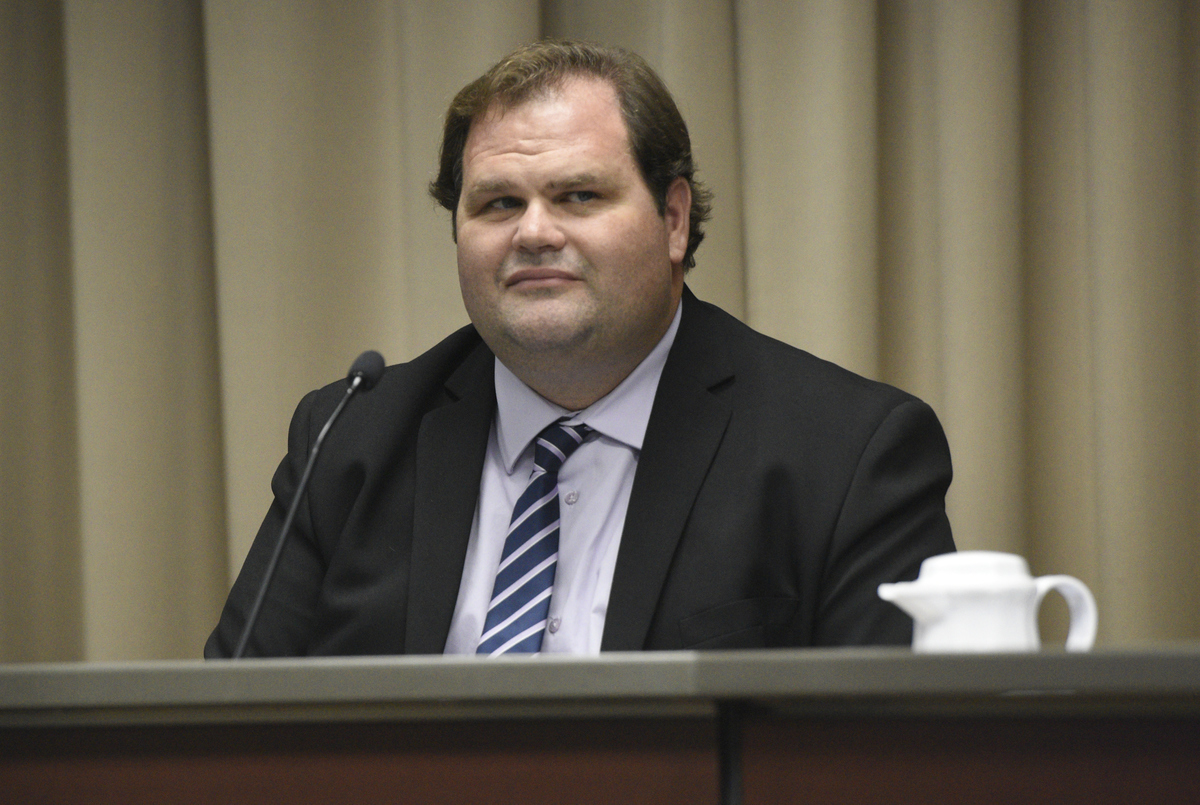Goleta Council Declares Racism a Public Health Emergency
Santa Barbara County Sheriff Grilled over Use of Force

Racism is a public health emergency, the Goleta City Council vowed on Monday afternoon, voting unanimously for a resolution to support Black Lives Matter and their residents in living free from a fear of the police. But first, Councilmember James Kyriaco grilled Santa Barbara County Sheriff Bill Brown — whose deputies provide policing in Goleta — on neck restraints and his department’s use-of-force policy. Brown was prepared, with Goleta’s chief of police, Lieutenant Rich Brittingham, handing him statistics off-camera.
Kyriaco wanted to know about a neck hold called the vertical lateral restraint, which was allowed in the Sheriff’s Office. “In the last five years,” Brown replied, “it’s been used three times by the Sheriff’s Office.” It places pressure on the carotid artery, restricting blood and oxygen to the brain, rather than to the front of the throat and a person’s airway, he told the council, who were meeting over a video feed that glitched out occasionally, depending on the counselor’s internet service. Brown argued it was a necessary “tool in the toolbox” that could avoid the use of deadly force. With the hiring of women and persons of smaller stature — Brown is the size of a young grizzly bear — “oftentimes we have a situation where deputies are in an altercation with someone who significantly outweighs them.”
The lateral vascular restraint was clearly a last resort, said Brown, used only in an actively violent attack against an officer, not for a passively resistant individual. It was taught at POST (the state’s Police Officer Standards and Training certification), the training his deputies receive. Brown said the Sheriff’s Office website displays the policy manual and training curriculum, which was frequently revised. The use-of-force policy, he stated, speaks of de-escalation and the sanctity of human life. “It emphasizes the duty of a deputy to stop another deputy engaged in excessive force, and to report it.”
Get the top stories in your inbox by signing up for our daily newsletter, Indy Today.
Brown went on to note the 8 Can’t Wait policing recommendations that included not shooting at a moving vehicle. Twice in this community, he said, vehicles have been used as “weapons of mass murder.” If his deputies hadn’t run after Elliot Rodger’s car, “engaging him in a gun battle and wounding him in his moving vehicle … there would have been more murders that day.”
The councilmember noted statistics for Santa Barbara’s police department, reported by the Independent here, that among the city’s 1.3 percent black population, the use of force against black people represented 8.7 percent of cases. Asked for similar statistics for Goleta, Brown had them countywide: Eight persons had been killed or seriously injured by his troops between 2013 and 2018 — 63 percent were Latinx, and 38 percent were white. Statistically, they encountered so few black people, Brown said, that the percentage who lived in his service area was listed as zero.
Brown added that he could provide better statistics if he had a data manager, which his budget could not afford. The information came from the data his office was required to send to the state and to the FBI. (The information can be found at Campaign Zero, Mayor Paula Perotte added.) When asked about body cams, Brown stated again that money constraints kept him from employing them throughout his forces — all cars have dash cams, however — and that he’d also need the funds for a manager to handle the video uploads and respond to inquiries for them.
Brown clearly had his budget on his mind. The county is discussing the next fiscal year this week, and Brown makes his pitch on Tuesday in the public safety portion of the discussion, which can be viewed live at a number of online county feeds.
When it came to oversight, Brown dug his heels in, citing cost again and saying they were “exorbitantly expensive to put together” as either a group of civilians or a hired consultant. “The community has the ultimate oversight,” he argued. “I have to get reelected every four years.” Goleta and Santa Barbara County are not Minneapolis, which has a police review board, he said, noting the irony. “I would submit to you, we do not have those sorts of underlying issues. If we did, I might be in favor of looking at it. But we have other needs in the Sheriff’s Office that are underfunded.”
Councilmember Kyle Richards, who had asked Goleta staff to prepare the resolution last Wednesday, told Brown that residents wanted oversight: “They want a say in holding the police accountable,” Richards said, suggesting more creative options were out there.
In response to Richards’s question about the militarization of the Sheriff’s Office, Brown listed the items they’d received from military surplus, again which he couldn’t otherwise afford to buy: four helicopters, an armored vehicle called an MRAP — which, along with the Bearcat vehicles, were needed to rescue Montecitans during 2018’s 1/9 Debris Flow — first aid gear, and ballistic helmets. They’d received no weaponry, Brown said, “except for some bayonets. We thought they’d make good utility knives, but because of the image, they were not appropriate; we sent them back.”
About two and a half hours into the meeting, Brown was visibly wilting in his chair, but continued to answer questions:
- Civilian review boards: Among about 18,000 police forces in the United States, about 150 existed.
- Complaints to his office: Handled by the Professional Standards Unit, which is a deputy sheriff sergeant, deputy sheriff investigator, and custody deputy investigator. “Some rural departments end up hiring people with blemishes in their record, even convicted of crime. … I can assure you, we would not hire a deputy with those types of incidences.”
- Protests: People have the right to assemble and ask for redress of a grievance, but his troops had to be prepared should it degenerate into looting.
“Police brutality and white supremacy have no place in our police force,” Brown told the council. Brown portrayed his deputies as members of the same communities. “Of the 28 deputies who work in Goleta, nine speak Spanish fluently,” Brown said, and five women are assigned to the city. He also raised recruitment issues, stating the danger was of “not seeing people of color or women wanting to get into law enforcement because of things that happen thousands of miles away.”
As the council struggled to be inclusive, accurate, thorough, and contemporary during the lengthy special meeting, they listened to Brown’s caution that some cases of use of force that were in the amended resolution — at the suggestion of Healing Justice Santa Barbara — had not yet been adjudicated. Others had a ruling of justified homicide by a district attorney, including the Meagan Hockaday case in Oxnard. “All the cases are tragic,” Brown said. “I wish they hadn’t occurred.” But not all cases were on the level of George Floyd and Ahmaud Arbery, who were unarmed, because some involved shooting or use of a knife at police officers, he said.
The council agreed to submit more detailed requests to the sheriff in a letter within two weeks. The resolution passed on Monday reads, in part:
“[F]rom slavery to Jim Crow laws to the modern criminal justice system, black people in this country have been brutalized and dehumanized for centuries, including Santa Barbara County’s first black enslaved resident, Jerry Forney. … [T]he struggles of black people have been highlighted most recently by alarming findings that black Americans are dying from COVID-19 at a much higher rate compared to white Americans due to systemic, structural racism. [And] …, in the 21st Century, black people in America continue to live in fear of losing their lives at the hands of law enforcement or members of white supremacist groups.”
In the mid-19th century, Forney arrived in Santa Barbara with his owner. He refused to return to North Carolina with him, instead recruiting 500 African Americans to come to Santa Barbara in 1881, according to the Roots of Community exhibit organized by special collections at the UC Santa Barbara library in 2008.
Forney’s story is a piece of history buried in a library, an example of how black voices have been “crying out for years,” said Councilmember Kyriaco. For instance, the death of Brenden Milo Lewis, he said. The SBCC student and football player was found dead in 2018, after being missing for three months. “His friends and family reported it,” Kyriaco related, “but it was not covered well. There are so many incidents like this.”
At the Santa Barbara Independent, our staff is working around the clock to cover every aspect of this crisis — sorting truth from rumor. Our reporters and editors are asking the tough questions of our public health officials and spreading the word about how we can all help one another. The community needs us — now more than ever — and we need you in order to keep doing the important work we do. Support the Independent by making a direct contribution or with a subscription to Indy+.



